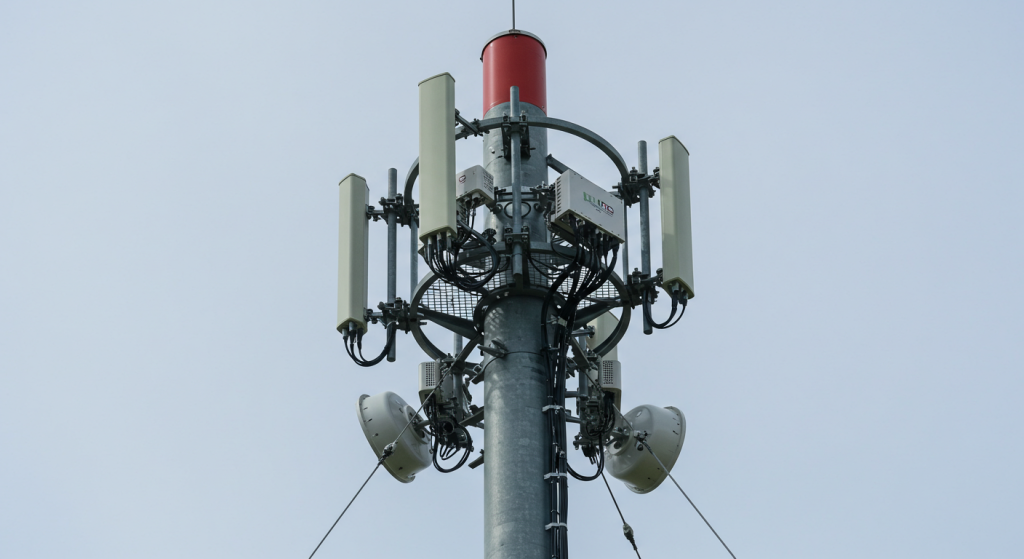Torres monopolo para el despliegue de celdas pequeñas: el futuro de 5G
2025-05-30
¿Qué es una torre monopolo para el despliegue de celdas pequeñas?
Las antenas de telecomunicaciones móviles y las torres de comunicación octogonales están contenidas en una torre monopolo para el despliegue de celdas pequeñas, que es uno de los tipos de torre monopolo. Esta torre tiene muy pocas estructuras paralelas y perpendiculares, y en la vista de las celdas pequeñas celulares, alimenta una huella estable en un área similar a un espacio de arrendamiento donde se pueden desacoplar celdas pequeñas 5G, tecnologías de onda milimétrica y unidades de radiación de radiofrecuencia.
A diferencia de las macrotorres tradicionales que abarcan 100+ pies, las torres celulares pequeñas monopolo compactas miden entre 20 y 60 pies de altura. Esto los hace ideales para implementaciones de telecomunicaciones urbanas y estéticas en áreas densamente pobladas.
¿Por qué elegir un monopolo para infraestructura de celdas pequeñas?
Estas son las ventajas clave:
• Las celdas pequeñas monopolo se pueden implementar rápidamente: A diferencia de las torres de celosía o arriostradas, estas son más rápidas de instalar.
• Ahorro de espacio: las pequeñas torres celulares monopolo se pueden colocar prácticamente en cualquier lugar. Son ideales para aceras y azoteas.
• Zonificación discreta: Recibe un menor escrutinio y aprobación para la construcción en las ciudades.
• Bandera y palma patriota: Se pueden cubrir con diferentes logotipos y así ocultar su propósito real.
• Considerado como el pilar más eficaz para condiciones climáticas extremas.
El impacto de las celdas pequeñas en las redes inalámbricas futuras
La incorporación de la tecnología de celdas pequeñas es vital para lograr la densificación de la red móvil. Los operadores de redes móviles (MNO) tienen que mejorar tanto la capacidad como la cobertura de la red debido a la demanda cada vez mayor causada por la transmisión, los dispositivos inteligentes y el IoT.
Tipos de celdas pequeñas que encontrarás en Monopoles
1. Microceldas: cubra las cuadras de la ciudad con una fuerte intensidad de señal.
2. Picoceldas: Sirva a un área interior o pequeña al aire libre, como centros comerciales o estadios.
3. Femtoceldas: Destinado principalmente para uso personal y residencial dentro de una pequeña empresa.
Todo lo anterior encaja perfectamente en torres monopolo de celdas pequeñas, lo que permite una mayor cobertura celular, una conectividad de menor latencia y una mejor experiencia del usuario en áreas altamente pobladas.
Usos y ventajas: redefiniendo nuestro mundo digital
Los beneficios y características de la torre monopolo para el despliegue de celdas pequeñas van más allá de la infraestructura. Todas nuestras vidas conectadas también se ven afectadas.
¿Qué puede hacer el 5G?
El uso de celdas pequeñas 5G es la forma más efectiva de desbloquear las funciones de red inalámbrica de próxima generación. Permiten y garantizan la disponibilidad de la densidad necesaria para 5G de baja latencia, facilitando las velocidades súper rápidas del despliegue de ondas milimétricas. Esto permite:
• Banda ancha móvil mejorada: descargas súper rápidas, transmisión sin interrupciones y juegos sin demoras mientras viaja.
• Mayor capacidad de red: Permitir que se conecten más dispositivos al mismo tiempo sin ralentizar es especialmente crucial para las áreas urbanas abarrotadas.
• Uso de IAD y enlaces de acceso: los dispositivos de formación, como los sensores inteligentes y los automóviles autónomos, necesitan enlaces de comunicación ultraconfiables y de baja latencia para impulsar la conectividad de IoT.

Ciudad inteligente y transformación urbana
Los monopolos son esenciales en el despliegue urbano de celdas pequeñas. Son parte de la infraestructura de la ciudad inteligente y, a menudo, funcionan como postes de alumbrado público (celdas pequeñas de alumbrado público) o celdas pequeñas de postes de servicios públicos. Esta integración permite:
• Cobertura omnipresente: la ausencia de zonas muertas y una sólida cobertura de espera garantizan que no haya huecos mientras se desplaza por cualquier ciudad concurrida.
• Apoyo a los servicios municipales: Gestión inteligente del tráfico, aplicaciones de seguridad pública y monitoreo ambiental.
• Atractivo estético: Preservar la vista de los distritos históricos y las zonas arquitectónicas modernas.
Cerrar la brecha digital
Se trata más bien de un fenómeno urbano, pero la cobertura es igualmente importante para las células pequeñas rurales. Los monopostes son útiles, especialmente las mini torres celulares más pequeñas o los tipos de torres microcelulares, cuando se habla de extender la conectividad en áreas remotas. Sirven para llevar rápidamente los servicios a comunidades remotas para que otras empresas y residentes puedan hacer uso del servicio y, al mismo tiempo, habilitar la brecha digital.
- Más allá del aire libre: cobertura en edificios
Aunque intrínsecamente para uso externo, el concepto de celdas pequeñas se aplica a la cobertura en edificios. Los monopolos a menudo están equipados con nodos DAS (sistemas de antenas distribuidas) o picoceldas, que brindan una fuerte cobertura de señal para grandes áreas interiores como auditorios, sedes corporativas y centros comerciales.
Elegir a su compañero monopolo: una decisión crítica
Los operadores de redes móviles, las empresas de torres y los proveedores de servicios inalámbricos se enfrentan a un gran desafío: elegir el socio más adecuado para el despliegue de celdas pequeñas monopolares. La empresa seleccionada debe apreciar las complejidades de las soluciones de infraestructura inalámbrica para proporcionar productos y servicios confiables y fácilmente disponibles. Al considerar el proveedor de una celda pequeña monopolo o una torre monopolo, asegúrese de que tenga:
Experiencia en el suministro de estructuras internas personalizadas que maximizan el potencial de ganancias del sitio.
• Soluciones de marketing estético: Proporcionar una variedad de opciones de monopolos ocultos de los que no se avergonzarán.
• Soporte de marca de color: después de la fase de adquisición del sitio viene la obtención de permisos, la instalación, el mantenimiento y el soporte.
• Cumplir con la fecha límite: entregar proyectos dentro del presupuesto y contar con un historial de implementaciones dentro del alcance.
• Opciones rentables: priorizar el valor sin comprometer la calidad.
Ya sea que su objetivo sea comprar piezas de celdas pequeñas monopolo u obtener servicios completos de instalación de torres de celdas pequeñas, tener un socio como XY Tower, que tiene capacidades de diseño monopolo personalizadas y presencia mundial, hace que el proceso de implementación de celdas pequeñas en redes sea mucho más fácil.
Los cambios en las torres monopolo con respecto a la tecnología inalámbrica
En cada región donde la red 5G está disponible, las soluciones en materia de infraestructura son diferentes. Se espera que las torres futuras tengan:
• Unidades integradas de computación de borde (ECU)
• Monitoreo de tráfico y equilibrio de carga controlado por IA
• Compatibilidad mejorada con frecuencias de onda milimétrica
• La capacidad de recolectar energía del entorno para su uso fuera de la red
Es probable que las torres monopolo sirvan como el enlace principal para conectar ciudades, empresas y personas. Las empresas y las personas ahora pueden comunicarse de manera eficiente.
Infraestructura asequible para la instalación de monopolos 5G
Mantener una buena calidad mientras se reducen los costos es esencial. La forma en que las celdas pequeñas monopolo son útiles:
• Menos trabajo en el sitio: El tiempo de ingeniería civil se reduce porque las torres están preconstruidas.
• Co-Infraestructura: Las antenas de diferentes proveedores de servicios se pueden ensamblar en un solo lugar.
• Gran retorno de la inversión: las instalaciones rápidas permiten activaciones de red más rápidas.
Conclusión
La torre monopolo para el despliegue de celdas pequeñas es mucho más que una pieza de metal; por sí solos permiten nuestros próximos avances digitales. Como es el caso con todo, existe la necesidad de estructuras pequeñas, estéticamente agradables y duraderas tanto en aldeas remotas como en metrópolis bulliciosas, por XY Tower. 5G es un excelente ejemplo: transmitir y experimentar viajes inalámbricos a velocidades asombrosas es el objetivo del futuro, y estas torres sólidas avanzadas nos acercan un paso más a lograrlo. Sin duda, cada torre monopolo construye lentamente el futuro de la comunicación.

Hola, soy Chunjian Shu
"X.Y. Tower: Soluciones fiables e innovadoras para torres y equipos eléctricos de alta calidad con servicio profesional.
